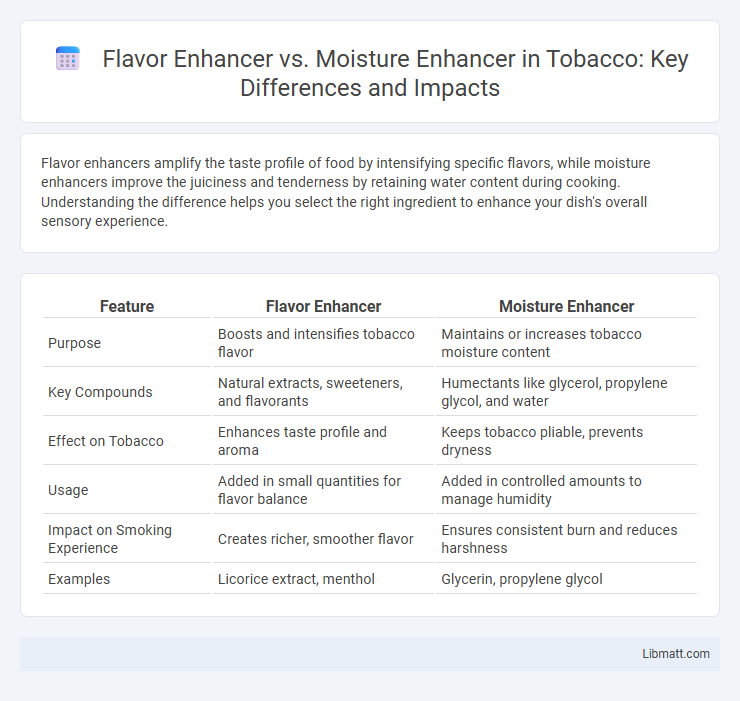Flavor enhancers amplify the taste profile of food by intensifying specific flavors, while moisture enhancers improve the juiciness and tenderness by retaining water content during cooking. Understanding the difference helps you select the right ingredient to enhance your dish's overall sensory experience.
Table of Comparison
| Feature | Flavor Enhancer | Moisture Enhancer |
|---|---|---|
| Purpose | Boosts and intensifies tobacco flavor | Maintains or increases tobacco moisture content |
| Key Compounds | Natural extracts, sweeteners, and flavorants | Humectants like glycerol, propylene glycol, and water |
| Effect on Tobacco | Enhances taste profile and aroma | Keeps tobacco pliable, prevents dryness |
| Usage | Added in small quantities for flavor balance | Added in controlled amounts to manage humidity |
| Impact on Smoking Experience | Creates richer, smoother flavor | Ensures consistent burn and reduces harshness |
| Examples | Licorice extract, menthol | Glycerin, propylene glycol |
Introduction to Flavor Enhancers vs Moisture Enhancers
Flavor enhancers intensify and balance the taste profile of food by amplifying existing flavors without adding new ones, commonly using substances like monosodium glutamate (MSG) or yeast extracts. Moisture enhancers improve the juiciness and texture of products by retaining water during processing and cooking, often achieved through ingredients such as phosphates or hydrocolloids. Both play crucial roles in food formulation, targeting sensory appeal and mouthfeel to meet consumer expectations.
Understanding Flavor Enhancers: Key Ingredients and Functions
Flavor enhancers such as monosodium glutamate (MSG), disodium inosinate, and disodium guanylate amplify the taste profile by stimulating umami receptors on the tongue, intensifying savory notes without adding additional seasoning. Moisture enhancers, often comprising phosphates, sodium citrate, and natural extracts, improve juiciness and texture in processed foods by retaining water and preventing protein denaturation during cooking. Understanding the distinct roles of these key ingredients helps optimize food formulations for enhanced palatability and sensory experience.
Moisture Enhancers: Definition and Primary Benefits
Moisture enhancers are additives used in food processing to increase water retention, improving the juiciness and texture of products like meats, baked goods, and processed foods. These enhancers help maintain moisture during cooking and storage, resulting in a tender, succulent final product that appeals to consumers seeking better mouthfeel and freshness. Common moisture enhancers include phosphates, carrageenan, and proteins, which also contribute to extended shelf life and reduced cooking losses.
How Flavor Enhancers Impact Taste and Senses
Flavor enhancers intensify the perception of taste by stimulating taste receptors and amplifying umami, sweet, or salty notes, creating a richer and more satisfying flavor profile. Unlike moisture enhancers, which primarily improve juiciness and texture, flavor enhancers directly influence sensory experience by triggering aroma and taste pathways in the brain. Common compounds like monosodium glutamate (MSG) enhance savory flavors, making foods more palatable and emotionally engaging for consumers.
Moisture Enhancers: Improving Texture and Juiciness
Moisture enhancers significantly improve the texture and juiciness of food by retaining water during cooking, which prevents dryness and enhances tenderness. Unlike flavor enhancers that primarily boost taste by amplifying specific flavor compounds, moisture enhancers work by binding water molecules within the food matrix, ensuring a moist, succulent bite. Your culinary creations benefit from moisture enhancers by delivering a more pleasurable eating experience with improved mouthfeel and reduced shrinkage.
Common Types of Flavor Enhancers in the Food Industry
Common types of flavor enhancers in the food industry include monosodium glutamate (MSG), disodium inosinate, and disodium guanylate, which intensify savory and umami tastes. Natural alternatives such as yeast extracts, hydrolyzed vegetable proteins, and mushroom extracts are widely used to boost flavor profiles without artificial additives. These enhancers improve sensory appeal in processed foods, soups, sauces, and snacks by amplifying existing flavors and masking off-notes.
Popular Moisture Enhancers and Their Applications
Popular moisture enhancers include glycerol, sodium lactate, and phosphates, widely used in meat processing to improve juiciness and tenderness. These ingredients increase water retention, enhancing the texture and shelf life of products like sausages, deli meats, and poultry. Phosphates are particularly effective in binding water and stabilizing protein structures, making them essential in both fresh and processed meat applications.
Comparing the Effects: Flavor Enhancers vs Moisture Enhancers
Flavor enhancers amplify the taste profile of food by intensifying savory, sweet, or umami notes without altering texture, while moisture enhancers improve juiciness and tenderness by retaining water within the product. Your choice depends on whether the goal is to boost sensory appeal through taste or to enhance mouthfeel and succulence. Both additives play distinct roles in food formulation, with flavor enhancers targeting sensory experience and moisture enhancers focusing on product moisture retention.
Culinary Uses: When to Choose Flavor or Moisture Enhancers
Flavor enhancers are ideal for intensifying taste profiles in soups, sauces, and processed snacks without altering texture, making them perfect for dishes requiring a pronounced savory or umami boost. Moisture enhancers are best suited for baked goods, meats, and frozen foods where maintaining juiciness and tenderness is critical to mouthfeel and overall quality. Selecting between these enhancers depends on whether the primary goal is to elevate flavor complexity or to improve moisture retention and product softness.
Health and Safety Considerations for Enhancers in Food
Flavor enhancers like monosodium glutamate (MSG) and moisture enhancers such as phosphates are regulated by food safety authorities to ensure safe consumption levels and minimize adverse health effects. Excessive intake of flavor enhancers can lead to symptoms like headaches or allergic reactions, while improper use of moisture enhancers may affect mineral balance and contribute to digestive issues. Manufacturers must adhere to strict guidelines on enhancer concentrations and conduct thorough testing to guarantee product safety and consumer health.
Flavor enhancer vs Moisture enhancer Infographic

 libmatt.com
libmatt.com